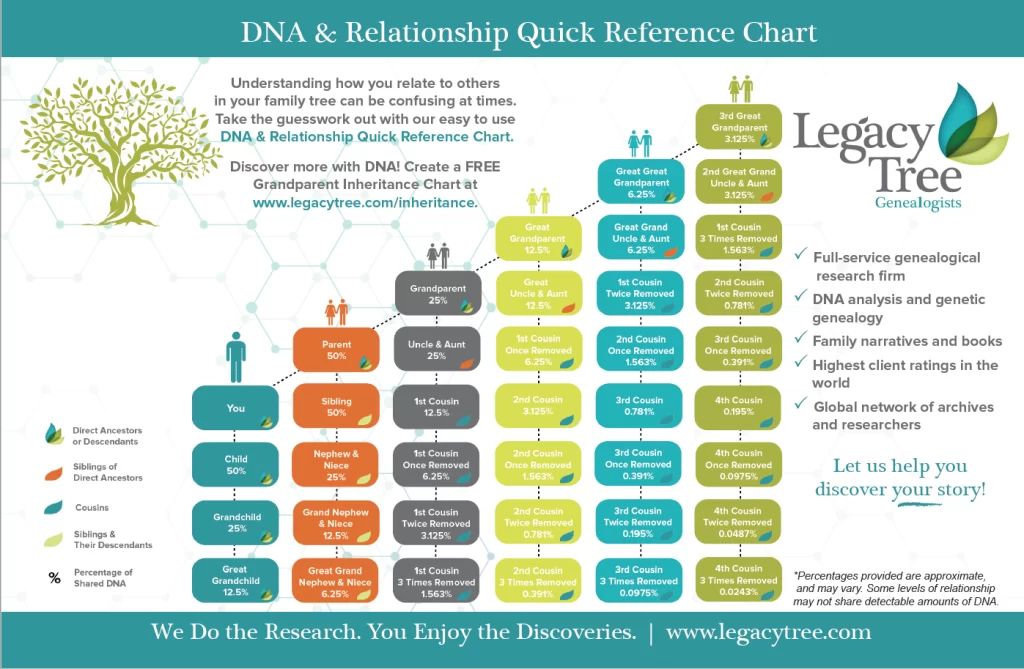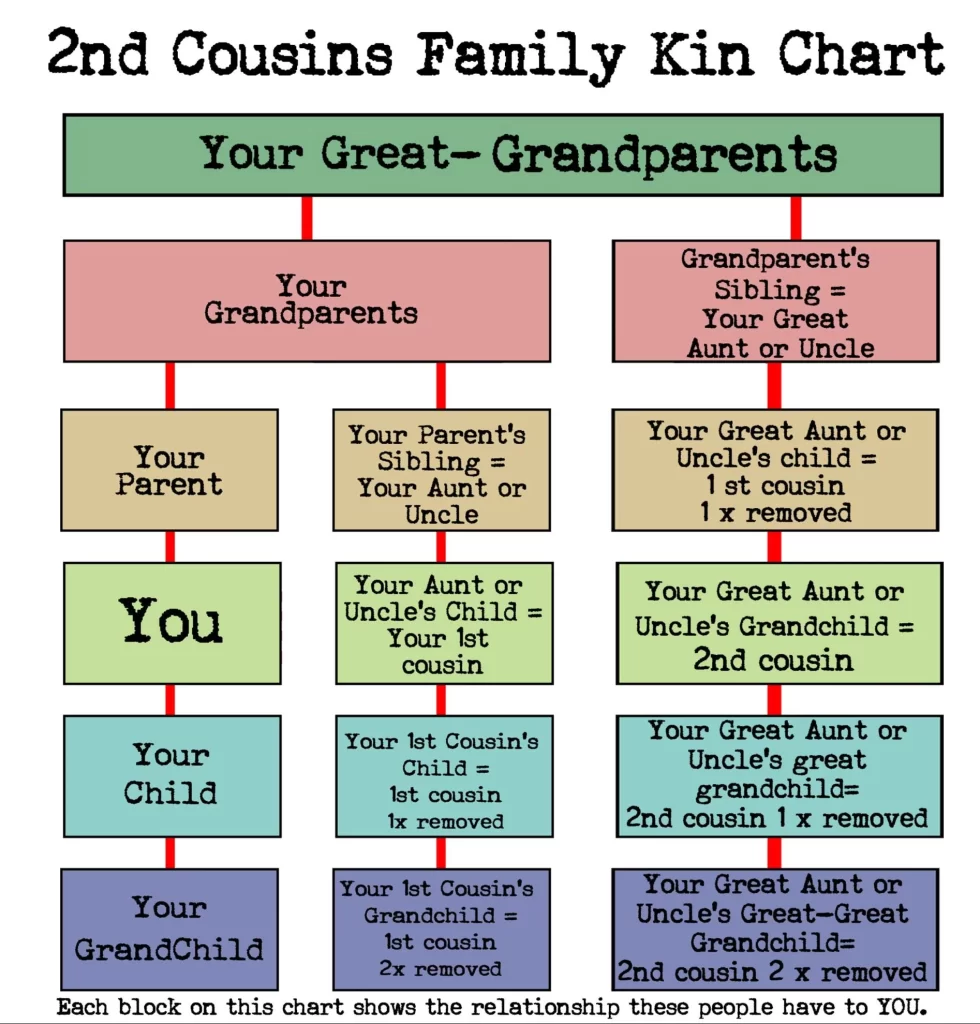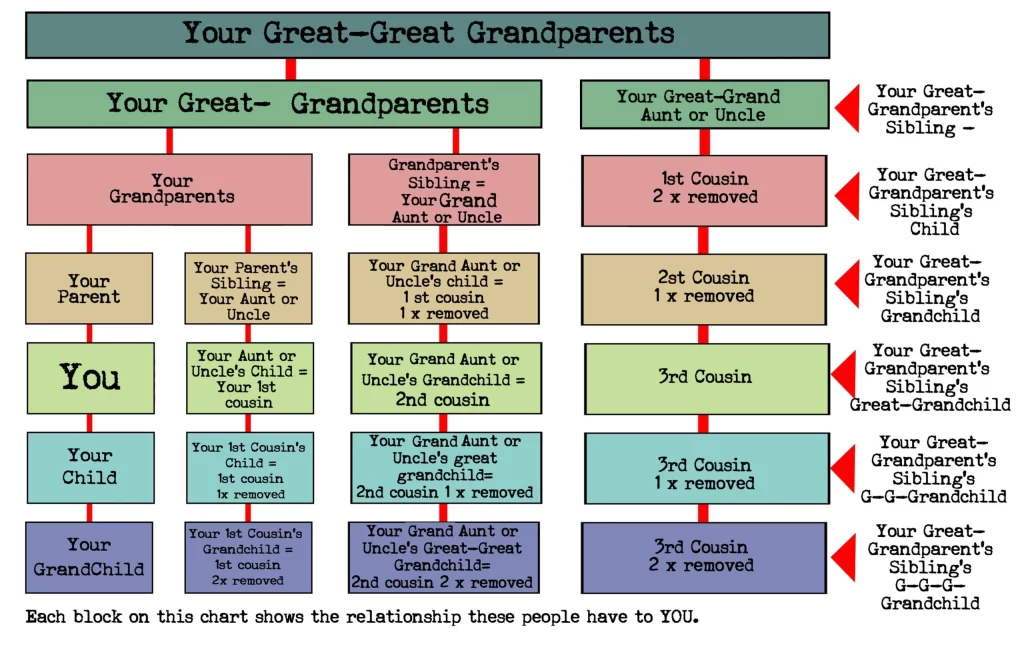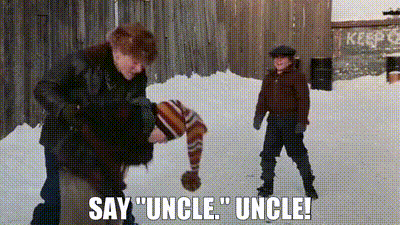When I was a young grasshopper and only beginning my genealogy nerdery, I remember the first time I laid eyes on one of those cousin charts. My Grandma Boreman sent it home with me along with a few copies of pictures and handwritten family trees.
It looked like this:

I promptly went cross eyed.
I studied and studied that thing—probably getting more confused each time I looked at it. For a while it wasn’t a priority to fully understand, as I was focused on direct ancestors. Over time, the distance of the relationship from person to person and how I talked about it became more meaningful as I started to care about being more accurate. So I had to figure this cousin thing out.
It also made a huge difference when I started to understand relationships through the DNA lens. The centimorgans that two people share directly correlates with who they are to each other label-wise. Obviously, there is a range of centimorgans to consider, but overall, if I knew someone on my tree to match with me as a first cousin, they should share between 396-1397cMs, with an average of 866 cMs.

Now, the half cousin range is actually 156-979cMs, so you might have to have others test or study the other matches that match both of you to be certain of your deduction of half or full relation. But with the average of a half first cousin being 449cMs, it is something to consider if you have any doubts.
For instance, on my dad’s side, my first cousin Emily and I had never known our connection to be any different than being first cousins our entire lives. She’s also a red head. She and her sister, my cousin Mandy, my sisters, and I all grew up together always playing together at every family gathering. Emily and Mandy were bridesmaids in my wedding. Full first cousins.
When the truth of things came out (as shared in my book The Record Keeper) Emily took a DNA test because of her own curiosity. Sure enough her match to me was only 318cMs. I went from having seven full first cousins to only having two. They are on my mom’s side, my cousins Jerich and Julie. So zero on my dad’s side now. The number went up to 16 half cousins!
While there can be outliers, Emily is 318cMs to me, and compared to full first cousins I know are accurate (my son and my sister’s son) you can see how the ranges and averages are pretty accurate with Miles and Titus sharing 940cMs.
So once some of my “new” cousins started taking tests, I was matching them at amounts of: 528 (Josh), 482 (Jen), 375 (Maria), and 318 (Emily). All half cousins.
But be warned! If you don’t know who they are personally, don’t assume a number within the range makes them a half-cousin! Because if you reference the chart from one of my previous blog posts, you’ll see that those numbers could also show them as a 2x Great Aunt / Uncle, 2x Great Niece / Nephew. Could also be a half Great-Aunt / Uncle, Half Great-Niece / Nephew, or a first cousin once removed (shown sometimes as 1C1R).
This is why you still need to research the person’s age, relationships to other family members around them, etc. Always have a few pieces of evidence to prove your findings.

Your first cousins are the children of your parents’ siblings. Your first cousins share the same grandparents as you. This is about as far as most of us get when understanding the whole cousin labeling thing. Seems easy enough, right?
Well, keep that in mind because that’s the key to this whole once, twice, three times a lady removed thing.
Your second cousins? You may quickly assume they are the kids of your first cousins.
You would be wrong.
They are not in the same generation, therefore they are your first cousins once removed. Their foundation lies in the fact that they are the children of your first cousins, the folks you share a grandparent with. But they are one generation removed from you. Hence the once removed.
Let’s go up a generation. So what about your parents? Their first cousins. Are they your second cousins? No they are not.
They are ALSO your first cousins once removed. They are only a generation removed from you, and it doesn’t matter if it’s “up or down” the ancestral line. Now you are well on your way to discovering who your 4th cousin 3x removed is! Okay, maybe there is more practice to be had.
This chart helps you identify the specific terms for different cousin relationships, making it easier to understand and categorize the connections within your family tree.
I know, I know, you are visual learners. So I’ll stop writing about it and show you a handy chart, much like the chart I saw all those years ago at my grandma’s house but a little less overwhelming. It can take time and practice to put all the connections in.

This is important in genealogical research as well as genetic genealogical research. This is what experts like CeCe Moore search for when they use a method referred to as reverse genealogy, also known as “descendancy research”. While the rule of thumb in genealogy is to start with what you know and work your way back to the past, this is the exception to the rule.
The reverse genealogy technique is used to narrow down or identify specific individuals within a family tree. CeCe and others that research for law enforcement trying to identify a victim or suspect in a cold case use this method. It is also helpful in discovering family members for adoptees and NPE (Non-paternity Event, or Not Parent Expected) individuals.



Source: https://roottobranches.com/
Second cousins share great-grandparents, third cousins share 2x great grandparents. Once you get back a ways, this is an easy way to remember: I Subtract “1” from the cousin relationship degree in order to know which direct ancestor you share. So your 6th cousin? You would share your 5x great grandparents. Easy.
Why bother calling people in your family the right things? We all have those people who are some extended type of cousin that we refer to or consider an aunt or uncle. Heck, maybe they aren’t even really related to you. That’s awesome to have those connections and you can call them whatever you darn well want.

However, if you are interested and serious in recording your family history and laying out the connections for posterity, then you might decide you need to be accurate in knowing who is who and how far away or closely you are related. It’s always a good thing to have a full and deep understanding of anything you are researching! Especially if you are trying to solve a DNA mystery.
For further reading, check out this blog on familysearch.org »
Don’t miss the next Get a Clue post.
Subscribe to my newsletter and get the latest article, practical
genie research hacks, updates about my book The Record Keeper, and more!

